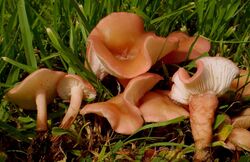Biology:Calocybe carnea
| Calocybe carnea | |
|---|---|

| |
| Scientific classification | |
| Kingdom: | |
| Division: | |
| Class: | |
| Order: | |
| Family: | |
| Genus: | |
| Species: | C. carnea
|
| Binomial name | |
| Calocybe carnea (Bull.) Donk
| |
| Synonyms | |
|
Tricholoma carneum (Bull.) P.Kumm | |
| Calocybe carnea | |
|---|---|
| Mycological characteristics | |
| gills on hymenium | |
| cap is convex or flat | |
| hymenium is adnexed or sinuate | |
| stipe is bare | |
| spore print is white | |
| ecology is saprotrophic | |
| edibility: edible | |
Calocybe carnea is a small pink-capped mushroom with white gills that can be found in grassy meadows, fields, or on lawns from spring to autumn in Europe and North America. Its common names include pink fairhead[3] and pink domecap.[4]
Taxonomy
Originally described as Agaricus carneus by the French mycologist Pierre Bulliard in 1792, this small pink mushroom has been through many taxonomical name changes over many years, and as a result has had many binomial names. A few of these are listed in the Synonyms section in the box at right. Its current specific epithet, carnea, is derived from the Latin for "flesh-coloured".[5] The genus name is derived from the Ancient Greek terms kalos "pretty", and cubos "head".[6]
Description
The cap is 1.5–4 cm (0.59–1.57 in) in diameter. It is usually pale pink, but can be darker, pinker, or redder. It usually fades with age. At first it is convex, but later flattens, and has a tendency to become wavy. It is smooth and dry. The stem is up to 4 cm (1.5 in) high and the same colour as the cap, and is smooth, or finely fibrillose;[2] often narrowing towards the base, and often misshapen. The gills are adnexed to almost free; sometimes notched and are white, giving a spore print of the same colour. They are quite closely spaced initially. The flesh is white; with very little taste, or smell.
A similar species, Calocybe persicolor (Fr.) Singer, grows in tufts, has a liking for manured ground, and is sometimes recorded as a variety or variant of C. carnea.
Distribution and habitat
Calocybe carnea appears in spring, summer, and early autumn (usually after rain). It is frequent in Britain, Europe, Asia, and North America, growing in grassy meadows and fields and on lawns. It is very rarely found in woods, unless a grassy clearing is present. It seems to tolerate agricultural practices, because its fruiting bodies often appear on fertilized farmland.[3]
Edibility
This mushroom is edible, but is unsubstantial, as it is small and thin fleshed. It is also potentially confused with poisonous species.[2]
References
- ↑ Regis Courtecuisse and Bernard Duhem ((British version) 1995). Mushrooms and Toadstools of Britain and Europe. Harper Collins. ISBN 978-0-00-220025-7.
- ↑ 2.0 2.1 2.2 David Arora (1986). Mushrooms Demystified. Ten Speed Press. p. 176. ISBN 978-0-89815-169-5. https://archive.org/details/mushroomsdemysti00aror_0/page/176.
- ↑ 3.0 3.1 Thomas Laessoe (1998). Mushrooms (flexi bound). Dorling Kindersley. ISBN 978-0-7513-1070-2.
- ↑ Roger Phillips (2006). Mushrooms. Pan MacMillan. p. 104. ISBN 978-0-330-44237-4.
- ↑ Simpson DP (1979). Cassell's Latin Dictionary (5 ed.). London: Cassell Ltd.. p. 883. ISBN 978-0-304-52257-6.
- ↑ Nilson S & Persson O (1977). Fungi of Northern Europe 2: Gill-Fungi. Penguin. p. 24. ISBN 978-0-14-063006-0.
Wikidata ☰ Q3490762 entry

